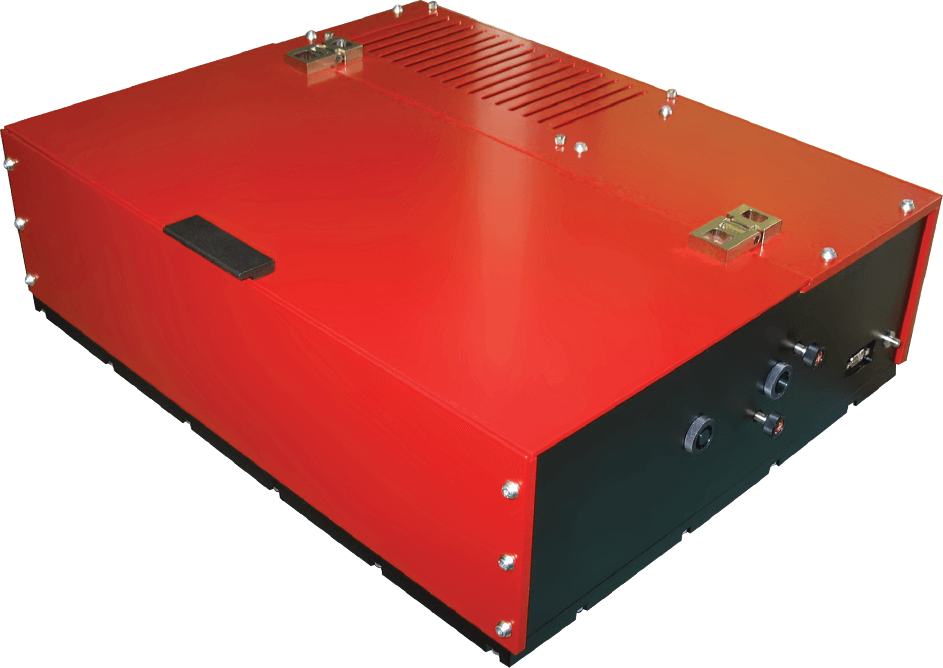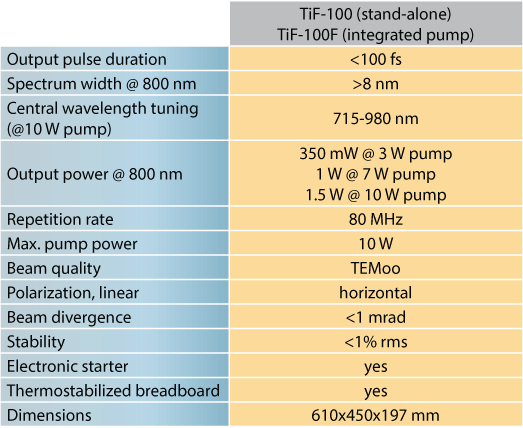TiF TiF-M, TiF-F Ti:S femtosecond solid-state tunable laser system
Broadest tuning range for a 50-fs laser: from 710 to 980 nm (@10 W pump, 2 mirror sets)
Output average power: up to 1.5 W (@10 W pump, 800 nm)
Automated USB wavelength tuning (with spectrometer option)
TTL pulse train output
Thermostabilized breadboard option
Combined CW/fs tunable operation option
Optional routing systems for microscope coupling

1. General
The TiF is a happy family of solid-state ultrafast titanium-sapphire laser systems that have long been the core product of our range. The most standard TiF Ti:S ultrashort-pulse laser is able to produce an 80-MHz femtosecond pulse train over a broad wavelength range from 710 to 980 nm* having the average power of up to 1.5 W at 800 nm*. Wavelength tuning is performed via a computer-controlled slit, and an optional built-in spectrometer is also available for fully automated procedure and precise wavelength control.
On request we provide a single set of optics with range from 720 to 860 nm or custom range. The system’s pulse duration can be factory preset from 20 to 100 fs. The electronic starter provides TTL signal for synchronization to the pulse train and maintains the stability of the mode-locked regime. Optional (-PRE) pulse precompensator assists to overcome the dispersion of short pulses by microscope’s optics or any other optical setups. Optional CW resonator arm (-CW) can be installed into the laser, thus providing CW capability along with fs mode.The laser can be based on one of the two optical schemes:
– the longer one (TiF, L=~1000 mm) for applications where space inside the laser might be used for additional equipment and even intracavity experiments. This model also suits nicely for educational purposes and postgraduate studies.
– the compact one (TiF-M, TiF-F, L=~550 mm) for applications where space on the optical table is of high demand. Usually these are complex setups that are combined with microscopes or other registration, beam shaping and diagnostic equipment.
If you do not have a suitable pump laser (DPSS 532 nm, CW, TEM00, low noise), consider the TiF-F – integrated pump laser option with average pump powers from 2 to 10 W (TiF-F2 to TiF-F10) to make your femtosecond oscillator system complete.
We also would be glad to provide routing systems for your microscope setup, just send us your dimensions and microscope details (mainly beam input height).
* – these specs are available with a 10 W pump laser.
2. Specifications

3. Modifications
-PRE – adds a built-it pulse stretcher/compressor unit that allows introducing of up to -13000 fs^2 of negative dispersion to your setup to compensate for dispersion in different microscopes and home-built optical setups. Or you can always positively chirp your pulse for longer duration. See APC page for details.
-SP – built-in spectrometer (necessary for fully automated tuning).
-PW – adds a built-in power meter for average power monitoring via USB.
-TS – thermostabilized breadboard for improved stability in volatile environmental conditions.
-CW – provides possibility of wavelength tuning and narrow bandwidth (<2 GHz) in CW generation mode (other options for CW are also available, see TiC)
-CH – re-circulating chiller option
-PR – the TiF laser requires horizontally polarized pump. If you already own a vertically polarized pump, you can rotate its pol by using our optional pol rotator.
4. Applications
MPE microscopy
Nonlinear microscopy
Terahertz generation
OCT (optical coherent tomography)
Two-photon absorption structuring
“Pump-probe” spectroscopy
Material deposition
Material processing
Seed oscillator for amplifier systems
5. FAQ
Q. Do I need a chiller for proper laser operation?
A. Tap water supply may be used to stabilize the system, but in this case we cannot guarantee the quoted stability. We recommend purchasing the –CH chiller option (see below) or using an existing lab chiller. The 2 and 3 W systems may operate without any water circulation at all, but again with no stability guarantee. Under room temperature the systems do not produce much heat to dissipate; the chiller is mainly required for stabilization purposes. If the laser and the chiller are operated around room temperature, then <60 W heat dissipation capacity is required from the chiller unit.
Two connection tubes are provided with the laser.
Q. What is the wavelength coverage of a single set of mirrors?
A. If required, the unit is supplied with one mirror set and the standard coverage is 720-860 nm. However, one set of mirrors can cover any 150-nm wide part of the full 710-980 nm wavelength range, the standard sets in two-set package being 710-850 nm and 850-980 nm, but custom sets are available.
Q. Can we change the rep rate of the TiF system?
A. The rep rate is 80 MHz by default on all systems. On custom basis the systems can be factory-adjusted to any rep rate in the range of 75 to 125 MHz, but this rate is fixed. However, upon request we can set a few positions of the cavity mirror to cover several fixed rep rates (say, 80/100/120 MHz), but changing between them will require the user to re-align the laser cavity.
Q. Can we change the pulse duration of the TiF system?
A. The pulse duration is factory preset to 20 or 50 or 100 fs (or custom). However, the standard 50-fs and 100-fs systems are both typically capable of pulse durations from 35 to 100 fs depending on the alignment of the prisms that can be tweaked by the user if necessary and the wavelength. But if you do not feel like doing it the systems always come preset to the desired pulse duration.
We also can equip the system with an APC pulse stretcher/compressor so you can chirp or compress your pulse if necessary.
Q. Does the pulse duration of the TiF laser change with wavelength tuning?
A. Yes, the pulse duration changes a bit while the laser is being wavelength-tuned, but pulse duration never goes beyond the quoted value (<20, <50 or <100 fs), it only gets less sometimes. E. g. the TiF 50-fs version typically has 50-fs pulses at around 730 nm, 40 fs at 800 nm and 35 fs at 950 nm. However, if exact pulse duration is necessary at certain wavelength it can be obtained by adjusting the prisms while tuned to this wavelength.
Q. Is it possible to get CW radiation and CW wavelength tuning out of the TiF fs system?
A. Yes, it is possible to get CW radiation out of a standard TiF system, but it will not be wavelength tunable and the bandwidth will not be specified. However, with the option –CW we install an additional arm to the fs cavity, that comprises the birefringent Lyot filter that allows USB CW wavelength tuning and narrows the bandwidth to <40 GHz. Furthermore, we can install optional etalons narrowing down the bandwidth to <2 GHz. Please note that the CW and fs modes cannot operate simultaneously, but are simply switched by a flip mount.
Q.What is the –TS option for and what are volatile lab conditions?
A. The –TS option is a thermostabilized breadboard that is connected to a chiller (option -CH) to stabilize the whole laser system. Such stabilization might be necessary if the environmental conditions of the lab are quite volatile. Under such conditions we mean no aircon or temperature changes over ±2° during the 8-hour period, air flow right over the optical surface, poor vibration protection, substantial amounts of dust.
Q. What equipment might be required to work with a fs Ti:S laser?
A. Here is the list of components that are not absolutely necessary, but might be very handy while working with a Ti:S femtosecond laser upon different experiments:
1. Power meter for control of output power value (or option –PW)
2. Interferometric autocorrelator for measurement of pulse duration with time resolution better than 10 fs. We offer our AA-10DD and AA-M autocorrelators.
3. Fast photodiode with 400 MHz oscilloscope to display the temporal structure of output radiation (the fast photodiode is built into the TiF’s electronic starter).
4. A photodiode with >10 mm^2 sensitive area or low-inertial power meter for fast control of relative output power in the process of alignment
5. During the alignment of the laser you may need two polarizers, we recommend polarization cubes or Glan laser prisms
6. Spectrometer or diffractive grating operating near 800 nm for spectrum control (or our –SP option)
7. Infrared sensor card for observation of weak IR luminescence
8. Infrared viewer
9. Dry nitrogen supply for purging the water vapor from the laser head for damp environment and some ultra-precise experiments at 960-980 nm
10. A chiller to keep the Ti:sapphire rod at a constant temperature for performance stability (option –CH). At least tap water source is required
6. RFQ Hints
Just some quick hints before you send us an RFQ:
1. Choose the right optical scheme for you – TiF (longer) or TiF>-M/TiF-F (compact) designs
2. Decide on whether you require a pump laser together with the system and select the pump power. Remember that tuning range and Ti:S output average power greatly depend on the pump level. See tuning curves for details.
3. Decide if you need full wavelength coverage or one central set of mirrors will do the job (720-860 nm). Also see tuning curves for possible wavelength coverage at different pump levels.
4. Equip your system with modifications if necessary. See the Modifications tab.
7. PDF & Extras